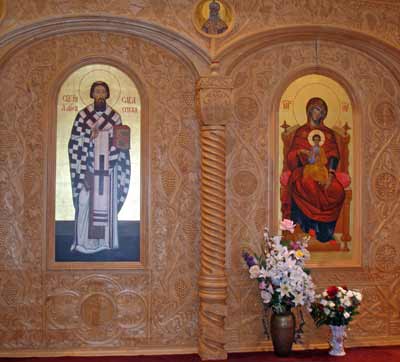The Serbian Orthodox people have the distinction of being the only Christians who have the beautiful religious custom of celebrating their "Krsna Slava" - Patron Saint.
This custom has been passed down from generation to generation since the year 765 A.D. To this day the Serbs honor the family patron saint and commemorate the day their forefathers accepted Christianity. The occasion is celebrated with a service in the church or at home conducted by the family's priest before a gathering of the family, relatives, and friends.
Even though Serbs worshipped and prayed to Almighty God, they took one day in the year to observe as a day of gratitude and thanksgiving to God for every blessing bestowed upon them. Thus, they chose a Christian saint or archangel whom they especially admired and respected and used as an example to try to be like him.
Usually the feast day or the chosen patron saint was nearest the day when the family converted to Christianity.
Prominently displayed in the home on this special holiday is a table bearing an icon of the patron saint, a lighted-decorated candle, a special bread-"kolach" a glass of wine and a bowl of wheat. The lighted candle shows the faith in God. It symbolizes' the happiness and holiness of the day. It is a symbof of the desires of the celebrant to know the light of life, of God and His son Jesus Christ: that the light of God will shine upon them; that it will make them good and virtuous Christians on earth; that the light will shine in their souls as does the light of the candle.
The bread kolach is a symbol of brotherly love. It represents that sacrifice as thanks to God for being saved through Christ. It is also a reminder of God's gift to man.
According to a prescribed rile for the occasion, the priest censes the table and those present. The censor and its contents symbolize the prayers which should come from a clean heart pleasing to God.
The priest reads the names of the family of the host, offering prayers for them. Then the priest blesses the bread, cuts it crosswise and pours wine into it. The cutting of the bread crosswise symbolizes the crucifixion of Christ for us. During this rite the bread is broken in half by the host and priest.
The members of the family and the priest kiss the bread three times (priest turns the bread thrice) during which time the priest says: "Christ is among us." The family replies "Indeed he is and shall be forever." The bread is broken into small portions and passed among the guests.
The wine symbolizes the blood of Christ which cleansed sins. It is a sign of rejoicing. The bread and wine are reminders of the last Supper.
The wheat kolijivo symbolizes the way of life. It is prepared and offered as a sacrifice to God in humble gratitude for all His earthly blessing and in memory of the saint commemorated and also the ancestors' of the family who lived in faith and who died for their religion. The sugar mixed with wheat represents the sweet life in Heaven after death.
The Krsna Slava Patron Saint celebration is still a dominant feature and symbol of the Serbs' religious life at home, in the church communities and organizations.

Top of Page
Back to Cleveland Serbians

